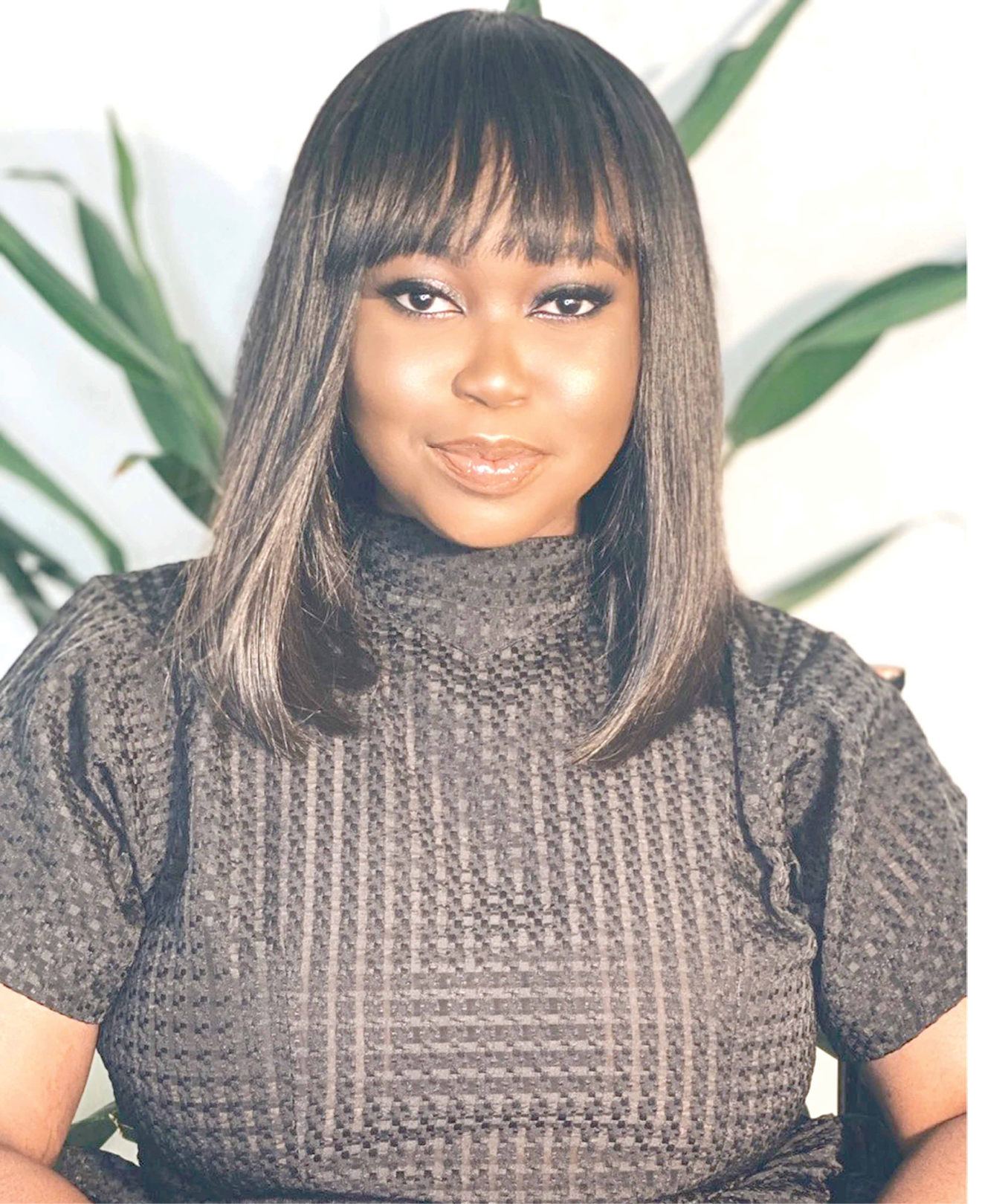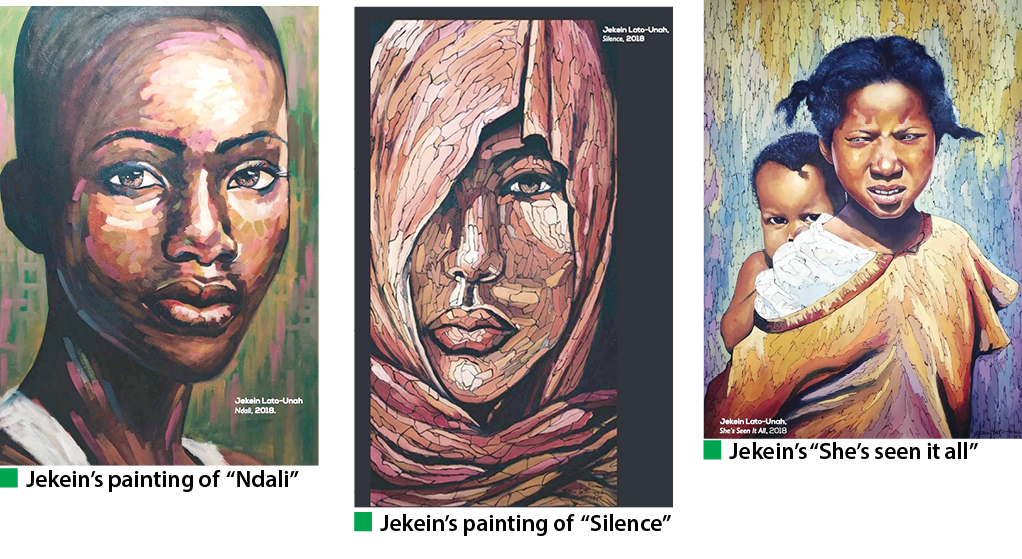Why my artworks focus on women – Jekein Lato-Unah
Jekein Lato-Unah is a Nigerian multidisciplinary artist trained in the art of pottery, painting and performance art whose primary interest seems to be to tackle patriarchy in Africa. She’s known for her use of symbols and patterns to create paintings celebrating women and frowning upon society’s marginalization of the female gender. Jekein Lato-Unah was in […]

Jekein Lato-Unah
Jekein Lato-Unah is a Nigerian multidisciplinary artist trained in the art of pottery, painting and performance art whose primary interest seems to be to tackle patriarchy in Africa. She’s known for her use of symbols and patterns to create paintings celebrating women and frowning upon society’s marginalization of the female gender. Jekein Lato-Unah was in conversation with Agbowo’s visual editor, Sheyi Owolabi. This interview was published in 2018 in Agbowo’s inaugural issue, X in a seven-part series.
To open the seal, we will like to know some things about you; your background, growing up, why and how you became an artist.
My name is Jekein Lato-Unah and I was born on the 4th of September, 1996. I am a multi-dimensional and experimental artist born and bred in Lagos, Nigeria. I am also currently a fourth-year Law student at the University of Lagos. Originally self-taught, I decided to undergo somewhat formal training. At 16, I began working with ceramics under the watch of Prof. Ndubuisi of Yabatech as I had always been fascinated with the idea of creation and creating things. I went ahead to bag certificates in pottery, painting, and performance art from Art Basis Institute, Dubai. Subsequently, I began painting and selling my work. In 2016, I studied and worked under Jelili Atiku and he held a performance art exhibition which was sponsored by ArtHouse Contemporary and The Goethe-Institut titled “A Day Exhibition.” It was held at the ArtHouse Residency where I was both a participant and the exhibition’s Art Director.
How would you describe your art form?
My art form is a mixture of fauvism and Araism, using mostly oil paint on canvas and furniture. My subjects involve regular people as the common denominators of our personal environment.
How do you work and what inspires your work?
I work in the garage in my home, usually scantily clad because I’m most comfortable that way so I’m reluctant to let people into my space. I’m currently known as the only woman in the Araism movement and I’m glad I chose this particular art form. My work is a response to my space, based on my interaction with my immediate environment and it conveys social, political and cultural issues in a thought-provoking manner that sparks discourse. Although my work may contain a lot of negativity, it is a direct reflection of the environment in which we Nigerians have found ourselves. However, there is positivity twisted into the fabric of that negativity and I ensure that my work represents that as well.
Day at Cape Coast Castle: Where Africans were shipped to Europe
Inside MMA2 Art Experience Centre

Someone once said, “Good art should disturb the comfortable and comfort the disturbed”. What message/messages do you try to convey to the audience via your art?
A lot of my work focuses on the less than ideal concepts that women have been subjected to– patriarchy, misogyny, and sexism. There is so much talk about them and incorporating these topics which I am passionate about, into my work acts not only as an outlet for me as a woman but as a reminder to people that these things exist. Art has always played an important role in the representation of social ills and my work is one of the many ways I contribute to these conversations. Hopefully, from confronting each other with these issues, we can come up with solutions to them.
We are sure you are familiar with a couple of African artists, dead or alive. Which of them has been your biggest influence?
Women like Ndidi Emefiele, Ndidi Dike, Njideka Akunyili-Crosby and Peju Alatise have been my biggest influencers in the industry so far.
What will you say is your favorite thing about being an artist?
My favorite part of being an artist is definitely the appreciation & connection people feel when they see my work. I’m filled with joy when they resonate deeply with what I’ve created and even when they don’t buy my art, the conversation that it inspires between people is fulfilling.
Like any other discipline making art definitely has its downsides. What have you observed to be the downsides to being an artist?
The biggest downside is the undervaluation of my work which is worsened by the fact that I am a woman. As a Nigerian in Nigeria, I know that artists aren’t appreciated enough. Everybody likes art but nobody wants to buy it for fear of making a bad investment. Also, like several other industries, the Nigerian art scene is male-dominated. This in itself is discouraging and when coupled with the belief that women cannot be as creative as their male counterparts, it makes things worse. However, I put these notions behind me and work hard to put them to shame. Also, the sexual harassment that comes with being a woman in a male-dominated industry is tough. People like me who are “emerging artists,” face the possibility of ostracism in the industry if we call out the gallery owners, artists, collectors and other perpetrators of these acts. The time will come when people will have the courage to speak up, but will anything be done about it? Find out in a couple of years.
When or how do you know a piece of art is finished?
My artwork is considered finished when I no longer question it.
In recent times, the spotlight has been on African art especially from the West. What is your opinion on the art scene in your country and Africa at large?
The spotlight should always be on Africa, nobody does it like us. The art scene in Nigeria is elitist and hinges on favoritism. Also, at every corner, there are people who would like to take advantage of you and your talent.
We like to see Art as a life form chiefly because it evolves and new trends can spring up from anywhere. What art trends are you following at the moment?
Currently, I’m researching and documenting the everyday life of different subjects including myself, working with bold wall colours in cold tones complimented by bright and warm colours using my Araism technique.
Culled: www.agbowo.org
